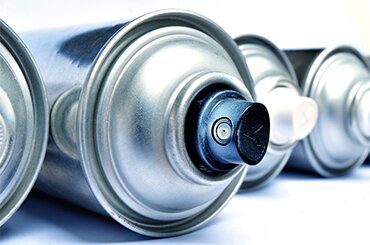- Availability
- Legality
- Price
- Quick-Acting
- Short-Lived Effects
- Easy to Use
- Easy to Conceal
- Hard to Detect
- Social Activity
- Unrecognized Hazards
- Sources
What are Inhalants?
The term "inhalants" comprises of a diverse group of legal substances that have a range of pharmacological effects. These substances are easily available--shoe polish, nail polish, deodorant, gasoline and lighter fluid are amongst the most commonly abused.
How are Inhalants Used?
Inhalants vaporize at room temperature, making abuse easy through the following methods of administration.
- Huffing: Breathing through a rag saturated with the chemical and placed over the mouth.
- Sniffing: Involves the same process as huffing, but the vapor is nasally sniffed.
- Bagging: Consists of transferring the chemical to a plastic bag, placing the bag over the nose and mouth, and breathing deeply.
Serious long-term effects may include:
- Liver and kidney damage.
- Heart failure.
- Brain damage due to hypoxia (lack of oxygen).
- Sudden death.
- Damaged nerves can lead to loss of coordination and movement.
The prevalence of inhalant abuse is greatest among 12-17-year-olds. If we exclude
alcohol and tobacco,
inhalant use among adolescents is second only to marijuana. If you or someone you love is abusing inhalants, it might be time to seek help. Treatment can help you avoid potentially life-threatening consequences. Please call
1-888-993-3112Who Answers? to speak to one of our treatment support staff today.
Therapists are Standing By to Treat Your Depression, Anxiety or Other Mental Health Needs
Explore Your Options Today
Ad
Availability
Inhalants are easily available.
- Based on this, most studies on inhalants conclude that initial use of inhalants before the age 12 is common.
- Additionally, the incidence of inhalants abuse is higher in "dry" communities, where alcohol access is restricted when compared to those in "wet" communities with easier access to alcohol.
Legality
The possession of household or industrial cleaning products is legal; this makes regulation of use difficult to enforce.
Additionally, there is no age restriction for possession as there is for other legal substances such as tobacco and alcohol.
Price
Inhalants are common household products, such as cleaners, aerosols, and dry-erase markers, hair spray, nail polish, and deodorants. These substances are a bargain compared with cocaine or marijuana, making them a great alternative for adolescents.
Quick-Acting
The high is not difficult to chase as intoxication occurs rapidly.
The time between inhalation and psychoactive effects for inhalant use is 7 to 10 seconds, compared to IV drug use, which is 15-30 seconds.
Short-Lived Effects
Not only does the onset of action occur rapidly but the effects are short-lived. Lasting up to five minutes. The effects cease as soon as the inhalant stops interacting with endorphin receptors in the brain.
This prevents detection by parents, as teens do not have to spend too much time away from family life or locked up in their rooms to achieve the high. They can keep up appearances quite easily.
Easy to Use
Just take a deep breath! There are no complicated processes involved and no external contraptions are required--like a spoon, needle or cotton in the case of heroin. Inhalants are directly accessible from a harmless container, such as whipped cream aerosol cans, a plastic bag, or a balloon filled with nitrous oxide.
Easy to Conceal
The smell of a drug is usually the strongest indicator of use but inhalant odors are a part of everyday life, thus making use very easy to conceal.
Further, inhalants evaporate quickly so compared to other drugs there is no residue or sign of use. Additionally, there is little or no cleaning up to be done, except to return the used whipped cream container to the fridge, next to the empty milk carton!
Hard to Detect
Inhalants are often preferred over other drugs because they are not easily detected in randomized drug screens. This lowers the possibility of being disciplined in school or arrested by police if a drug test is administered.
Detection is also directly influenced by external factors that impact patterns of use.
A disruptive family environment, for example, may also enable the inhalant use to fade into the background. If you or someone you know is suffering from inhalant addiction, treatment is available! Please call
1-888-993-3112Who Answers? and get help today.
Social Activity
The DSM-V (American Psychiatric Association, 2013) describes social activities associated with Inhalant Use Disorder as follows:
- A great deal of time is spent in activities devoted to obtaining inhalants.
- Use is recurrent and results in a failure to fulfill major obligations at work, school, or home.
- Important social, occupational or recreational activities are given up or reduced.
- There is a recurrent use of the inhalant substance in situations in which it is physically hazardous.
-

Research has demonstrated that inhalant use around social activity is prompted by two teen-related issues:
- The desire for social acceptance.
- The protective urge to reduce peer pressure.
Unrecognized Hazards
Adolescents do not realize that inhalants are extremely dangerous.
- While more than half the eighth-graders in one study saw the regular use of inhalants as hazardous, only a third of them attributed the same risk to using an inhalant once or twice.
Even a single exposure to inhalants can lead to long-term memory problems and mental processing impairments.
Further, it is very difficult to characterize the exact psychoactive effects of different substances, because they all have unique formulations. The lack of clarity around effects further causes kids to think that using inhalants socially may not be too harmful.
- The use of inhalant nitrates and alcohol have been found to be the two substances that best predict unprotected oral and anal sexual behaviors.
- This may result in the contraction of HIV-Aids and/or other sexually-transmitted diseases (STDs), significantly hampering the overall quality of life.
- Additionally, inhalant intoxication increases the risk for fatal injuries as the result of motor vehicle accidents.
Sources
American Psychiatric Association (2013). Diagnostic and Statistical Manual of Mental Disorders (5th Edition). Washington, DC: Author.
Balster, R.L. (2009). The Pharmacology of Inhalants. In Ries, R.K., et al., editors. Principles of Addiction Medicine. Fourth Edition. Philadelphia: Lippincott, Williams & Wilkins. 241-251.
Beauvais, F, and Oetting, E.R. (1988). Inhalant Abuse by Young Children. [Epidemiology of Inhalant Abuse: An Update: NIDA Research Monograph 85:1988.]
Collins, D., et al. (2015). Community Influence on Youth's Use of Inhalants and Other Legal Products to Get High in Rural Alaska. Journal of Child and Adolescent Substance Abuse. 23(4): 253-261.
Gahlinger, P. (2004). Illegal Drugs: A Complete Guide to Their History, Chemistry, Use, and Abuse. London: Plume/Penguin. 203-221.
Halkitis, P.N., and Parsons, J.T. (2002). Recreational Drug Use and HIV-Risk Sexual Behavior among Men Frequenting Gay Social Venues. Journal of Gay and Lesbian Social Services: Issues in Practice, Policy, & Research. 14(4):19-38.
Howard, M.O., et al. (2012). Inhalant Use and Inhalant Use Disorders in the United States. Addict Sci Clin Pract 6(1):18-31.
National Institute on Drug Abuse NIDA (2012). DrugFacts: Inhalants.
Oklan, A.M., and Henderson, S,J. (2014). Treating Inhalant Abuse in Adolescence: A Recorded Music Expressive Arts Intervention. Psychomusicology: Music, Mind and Brain. 24(3):231-237.
Rastegar, D.A., and Fingerhood, M.I. (2016). Inhalants: Volatile Organic Compounds, Nitrites, and Anesthetics. The American Society of Addiction Medicine Handbook of Addiction Medicine. New York: Oxford University Press. 241-282.
Siegel, J.T., et al. (2009). "... you would probably want to do it. Cause that's what made them popular": Exploring Perceptions of Inhalant Utility among Young Adolescent Nonusers and Occasional Users. Substance Use and Abuse 44(5):597-615.
Sharp, C.W., et al. (2011). Chapter 20: Inhalants. In Ruiz P., and Strain, E., editors. Lowinson and Ruiz's Substance Abuse: A Comprehensive Textbook. Philadelphia, PA: Lippincott, Williams, and Wilkins. 284-318.
Storie, M., et al., authors and editors. (2005). Module 1: Solvents / Inhalants. Basics of Addiction Counseling. Fairfax, VA: NAADAC.

